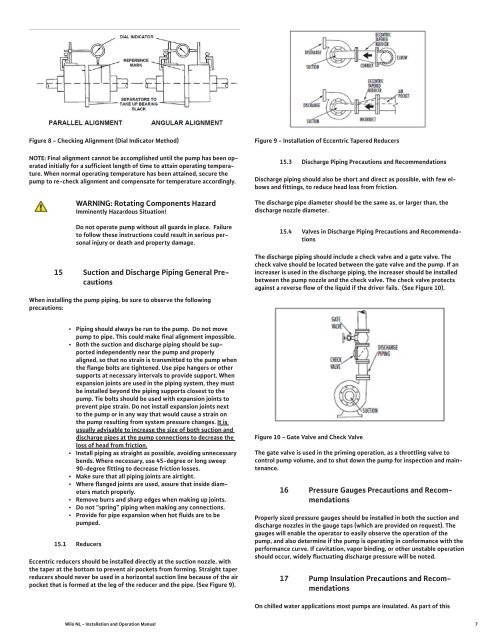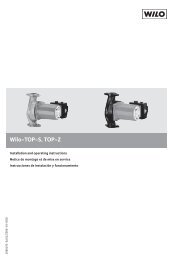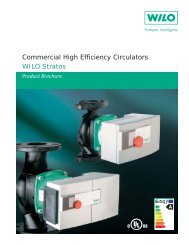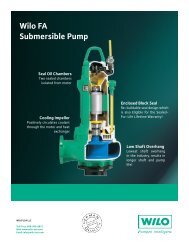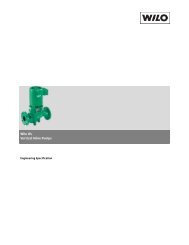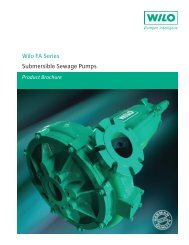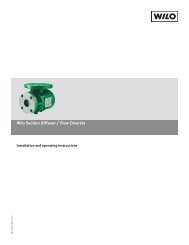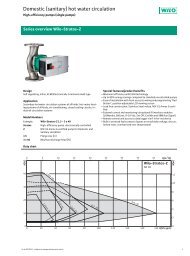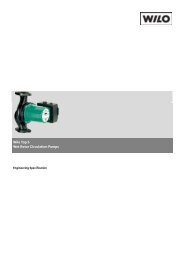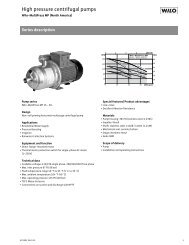14 Alignment ProcedureNOTE: A ‘flexible coupling’ will only compensate for small amounts of misalignment.Permissible misalignment will vary with the make of coupling.Consult coupling manufacturer’s data for specific tolerances.Allowances are to be made for thermal expansion during cold alignment,so that the coupling will be aligned at operating temperature. In all cases,a coupling must be in alignment for continuous operation. Even though thecoupling may be lubricated, misalignment causes excessive wear, vibration,and bearing loads that result in premature bearing failure and ultimate seizingof the pump. Misalignment can be angular, parallel, or a combination ofthese, and in the horizontal and vertical planes. Final alignment should bemade by moving and shimming the pump or motor on the base plate, untilthe coupling hubs are within the recommended tolerances measured in totalrun-out. All measurements should be taken with the pump and motor footbolts tightened. The shaft of sleeve bearing motors should be in the centerof its mechanical float.To check parallel alignment:• A straight edge should be held against the edges of thecoupling halves at any four places 90° apart around thecoupling.• The straight edge should be parallel to the pump anddriver shafts at all times.• Insert shims until the straight edge lies flat against bothcoupling halves at all four checkpoints.• The pump and driver will then be in proper parallel alignment.NOTE: Proper alignment is essential for correct pump operation. This shouldbe performed after base plate has been properly set and grout has driedthoroughly according to instructions. Final alignment should be made byshimming driver only. Alignment should be made at operating temperatures.WARNING: Unexpected Start-up HazardImminently Hazardous Situation!Disconnect and lock out power before servicing. Failureto follow these instructions could result in serious personalinjury or death and property damage.14.1 Initial Alignment of the Flexible Coupling (See figure 7)The pump and driver were accurately aligned at the factory. However, it isimpossible to maintain this alignment during shipping and handling. Thereforeit will be necessary for you to realign the pump and driver. Flexible couplingsare not universal joints. They should not be used to compensate formisalignment of the pump and motor shafts. Their function is to transmitpower from the driver to the pump while compensating for thermal expansionand shaft end movement. The coupling faces should be far enoughapart so that they do not make contact when the motor shaft is forced tothe limit of the bearing clearance toward the pump shaft.In order to properly align the coupling, you will need a taper gauge or set offeeler gauges, and a straight edge.There are two types of misalignment encountered with flexible couplings:angular misalignment, in which the shafts are not parallel, and parallel misalignmentwhere the shafts are parallel but not on the same axis.To check angular alignment:• Insert a feeler gauge or taper gage at any four places 90°apart around the coupling halves.• Insert shims under the driver feet until the same readingis obtained at all four check points.• The pump and driver will then be in angular alignment.Figure 7 - Checking Alignment (Straight Edge Method)14.2 For Fine Aignment, 3500 RPM OPERATION, For OtherCoupler Types (See figure 8)A dial indicator should be used when greater alignment accuracy is required.Use the following alignment tolerances unless specified otherwise by thecoupling manufacturer. On sleeve type couplings make sure there is atleast 1/8 inch [3mm] end clearance between the sleeve and the two couplinghalves.To check angular misalignment:• <strong>Mount</strong> the dial indicator base to the coupling half, andposition the dial indicator button on the front or rear faceof the opposite coupling half.• Set the dial to zero, rotate both coupling halves together,making sure the indicator• button always indicates off the same spot.• Misalignment values within 0.004 inches [.10mm] TIR perinch [25mm] of coupler radius is permissible.To check parallel misalignment:• <strong>Mount</strong> the dial indicator base to one coupling half, orshaft and position the dial indicator button on the outsidediameter of the opposite coupling half.• Set the dial to zero, rotate both coupling halves together,making sure the indicator button always indicates off thesame spot.• Misalignment within 0.004 inches [.10mm] TIR is permissible.6 WIL-IOM-<strong>NL</strong>002-10-11
Figure 8 - Checking Alignment (Dial Indicator Method)NOTE: Final alignment cannot be accomplished until the pump has been operatedinitially for a sufficient length of time to attain operating temperature.When normal operating temperature has been attained, secure thepump to re-check alignment and compensate for temperature accordingly.WARNING: Rotating Components HazardImminently Hazardous Situation!Do not operate pump without all guards in place. Failureto follow these instructions could result in serious personalinjury or death and property damage.15 <strong>Suction</strong> and Discharge Piping General PrecautionsFigure 9 - Installation of Eccentric Tapered Reducers15.3 Discharge Piping Precautions and RecommendationsDischarge piping should also be short and direct as possible, with few elbowsand fittings, to reduce head loss from friction.The discharge pipe diameter should be the same as, or larger than, thedischarge nozzle diameter.15.4 Valves in Discharge Piping Precautions and RecommendationsThe discharge piping should include a check valve and a gate valve. Thecheck valve should be located between the gate valve and the pump. If anincreaser is used in the discharge piping, the increaser should be installedbetween the pump nozzle and the check valve. The check valve protectsagainst a reverse flow of the liquid if the driver fails. (See Figure 10).When installing the pump piping, be sure to observe the followingprecautions:• Piping should always be run to the pump. Do not movepump to pipe. This could make final alignment impossible.• Both the suction and discharge piping should be supportedindependently near the pump and properlyaligned, so that no strain is transmitted to the pump whenthe flange bolts are tightened. Use pipe hangers or othersupports at necessary intervals to provide support. Whenexpansion joints are used in the piping system, they mustbe installed beyond the piping supports closest to thepump. Tie bolts should be used with expansion joints toprevent pipe strain. Do not install expansion joints nextto the pump or in any way that would cause a strain onthe pump resulting from system pressure changes. It isusually advisable to increase the size of both suction anddischarge pipes at the pump connections to decrease theloss of head from friction.• Install piping as straight as possible, avoiding unnecessarybends. Where necessary, use 45-degree or long sweep90-degree fitting to decrease friction losses.• Make sure that all piping joints are airtight.• Where flanged joints are used, assure that inside diametersmatch properly.• Remove burrs and sharp edges when making up joints.• Do not “spring” piping when making any connections.• Provide for pipe expansion when hot fluids are to bepumped.15.1 ReducersEccentric reducers should be installed directly at the suction nozzle, withthe taper at the bottom to prevent air pockets from forming. Straight taperreducers should never be used in a horizontal suction line because of the airpocket that is formed at the leg of the reducer and the pipe. (See Figure 9).Figure 10 - Gate Valve and Check ValveThe gate valve is used in the priming operation, as a throttling valve tocontrol pump volume, and to shut down the pump for inspection and maintenance.16 Pressure Gauges Precautions and RecommendationsProperly sized pressure gauges should be installed in both the suction anddischarge nozzles in the gauge taps (which are provided on request). Thegauges will enable the operator to easily observe the operation of thepump, and also determine if the pump is operating in conformance with theperformance curve. If cavitation, vapor binding, or other unstable operationshould occur, widely fluctuating discharge pressure will be noted.17 Pump Insulation Precautions and RecommendationsOn chilled water applications most pumps are insulated. As part of this<strong>Wilo</strong> <strong>NL</strong> - Installation and Operation Manual7


